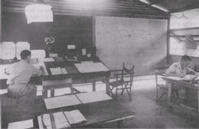


War History of the Australian Meteorological Service
Foreword
Preface
Introduction
Chapter 1: D.Met.S.—Australia's Wartime Weather Service
Chapter 2: The Weather Factor in Warfare
Chapter 3: Met in the Retreat
Chapter 4: Met in the Advance
Chapter 5: Meteorology in Aviation
Functions and Wartime Development
Service at RAAF Training Schools and Stations
Cooperation with US Personnel
Operational Expansion
Movement into Borneo
Chapter 6: Central Forecasting Services
Chapter 7: Met With the Army
Chapter 8: Research and Personnel Training
Chapter 9: Instrumental Development and Maintenance
Chapter 10: Scientific Developments in the RAAF Meteorological Service
Chapter 11: Divisional Bureaux and Their Work
Appendix 1: List of Reports Provided by D.Met.S. for Advances Operational Planning and Other Purposes
Appendix 2: List of Service Personnel RAAF Meteorological Service
Appendix 3: List of Civilian Personnel Who Worked Together with Service Personnel of the RAAF Meteorological Service
Appendix 4: List of Locations at which RAAF Meteorological Service Personnel Served
Index
Search
Help
Contact us

Operational Expansion
Throughout 1943 and 1944 aviation weather sections increased greatly in number throughout the operational areas. In the Pacific, new stations were established in New Guinea, New Britain and adjoining areas to provide meteorological service for our advancing air squadrons, while in the North-Western Area and Western Area aviation meteorological facilities were provided at such places as Gove Field, Fenton, Truscott, Exmouth, Meekatharra and Noonkanbah, where new RAAF aerodromes had come into being. Weather personnel staffing these and other advanced stations found the going hard on many occasions, for often their first task on movement to a new location was the physical one of building an office from virgin timber and furniture from packing cases and other available waste material. Duty hours were long, for in most cases a round-the-clock weather service was provided; the demand for aviation forecasts was heavy and in isolated areas communications difficulties were often exacting, but the fine cooperation and comradeship that grew up between meteorological and aircrew members was more than sufficient to offset these hardships.
Nor was the expansion of aviation met services confined to the Pacific and continental Australia. In August 1943 two RAAF weather men left Learmonth (WA) in a United States Navy Catalina flying boat to establish a reporting station at lonely Cocos Island, in the Indian Ocean, where the German raider Emden had been sunk by the Australian cruiser Sydney during World War I. The island had already been shelled by an enemy submarine, although no landing was ever attempted, but establishment of a weather station there was felt to be necessary to provide detailed reports for the RAAF and RAF aviation met officers forecasting in Perth and Colombo for the trans-Indian Ocean air transport route—then the longest single hop in the world. On this occasion the flying boat was briefed at American headquarters in Learmonth and set off to find Cocos Island in daylight, but by late in the afternoon the flying boat was lost and advised Learmonth by radio of its intention to return, with very little reserve of petrol. When the evening was well advanced Sqn Ldr J. (Doc) Hogan, the RAAF weather officer who had successfully forecast for the initial trans-Indian Ocean service crossing, was instructed to attend at air operations room to assist in finding the aircraft. This was eventually done and the pilot was advised to climb to 10 000 feet to gain advantage of tail winds on the return trip. Meanwhile, on the plane, the meteorological men and others were instructed to don their lifebelts. All bunks, bedding, loose equipment, instruments and supplies were dumped overboard to lighten the aircraft and it arrived back at Leamonth with the needle on both fuel gauges showing empty.
A second attempt was made some time later by a Catalina operated by Qantas, leaving Western Australia on a night selected for astro-navigation conditions and for the likelihood of a fine morning at the terminal, which was successfully reached at 6 am. The RAAF weather men became established from then onwards, making the island an extremely important one from the meteorological point of view, since not only did it supply weather and upper wind data for the trans-Indian Ocean crossing, but also valuable information enabling cyclones to be discovered in their early stages of development and their direction and movement forecast for the fleet units, cargo ships and transports operating in the Indian Ocean. Subsequently, in 1945, the Australian aviation men at Cocos Island were relieved by RAF weather personnel from South-East Asian Command.
Organisations in Australian Science at Work - Directorate of Meteorological Services (D.Met.S)
People in Bright Sparcs - Hogan, John (Doc)
 |
Bureau of Meteorology |  |
© Online Edition Australian Science and Technology Heritage Centre and Bureau of Meteorology 2001
Published by Australian Science and Technology Heritage Centre, using the Web Academic Resource Publisher
http://www.austehc.unimelb.edu.au/fam/0671.html